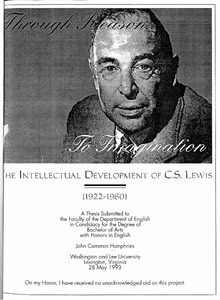| dc.rights.license | In Copyright | en_US |
| dc.creator | Humphries, John Cameron | |
| dc.date.accessioned | 2023-10-20T18:01:01Z | |
| dc.date.available | 2023-10-20T18:01:01Z | |
| dc.date.created | 1993 | |
| dc.identifier | WLURG038_Humphries_thesis_1993 | |
| dc.identifier.uri | https://dspace.wlu.edu/handle/11021/36477 | |
| dc.description.abstract | Lewis' literary transformation is, too, complete. The Oxford youth who intended to fashion a philosophic New Look simply because he was "against government" surrendered not only his will but also his reason to the depths of Christian understanding. Lewis, in different periods of his life, embodied several characters of Till We Have Faces. In his undergraduate days and afterwards, he was the Fox, cunning and insistent on the validity of what could be seen and observed, what could be rationally and objectively proven. But Lewis was also Orual: a man who never experienced eros until late in his life, and a man who achieved his fullest potential as a writer, thinker, and Christian by way of his shortcomings, of which the Anscombe encounters and his atheist undergraduate days constitute only the two most obvious examples. C.S. Lewis ranks among a small handful of the most influential Christian thinkers of the twentieth century. His enduring popularity is due to his Christian apologetic "short takes", The Screwtape Letters, The Problem of Pain, Mere Christianity, and The Abolition of Man. His most significant contributions, however, were his last, Till We Have Faces especially. Lewis acknowledged that "an apologist who is focusing on arguments for the existence of God cannot at the same time be tasting the reality of God" . . . In Till We Have Faces, Lewis successfully transcends reason through imagination and myth, witnessing and exposing a fragment of the true light by his own lies of poets breathed through silver. [From concluding section] | en_US |
| dc.format.extent | 77 pages | en_US |
| dc.language.iso | en_US | en_US |
| dc.rights | This material is made available for use in research, teaching, and private study, pursuant to U.S. Copyright law. The user assumes full responsibility for any use of the materials, including but not limited to, infringement of copyright and publication rights of reproduced materials. Any materials used should be fully credited with the source. | en_US |
| dc.rights.uri | http://rightsstatements.org/vocab/InC/1.0/ | en_US |
| dc.subject.other | Washington and Lee University -- Honors in English | en_US |
| dc.title | Through Reason to Imagination: The Intellectual Development of C. S. Lewis (1922-1960) | en_US |
| dc.type | Text | en_US |
| dcterms.isPartOf | WLURG038 - Student Papers | en_US |
| dc.rights.holder | Humphries, John Cameron | en_US |
| dc.subject.fast | Lewis, C. S. (Clive Staples), 1898-1963 | en_US |
| dc.subject.fast | Criticism, interpretation, etc. | en_US |
| dc.subject.fast | Apologetics | en_US |
| local.department | English | en_US |
